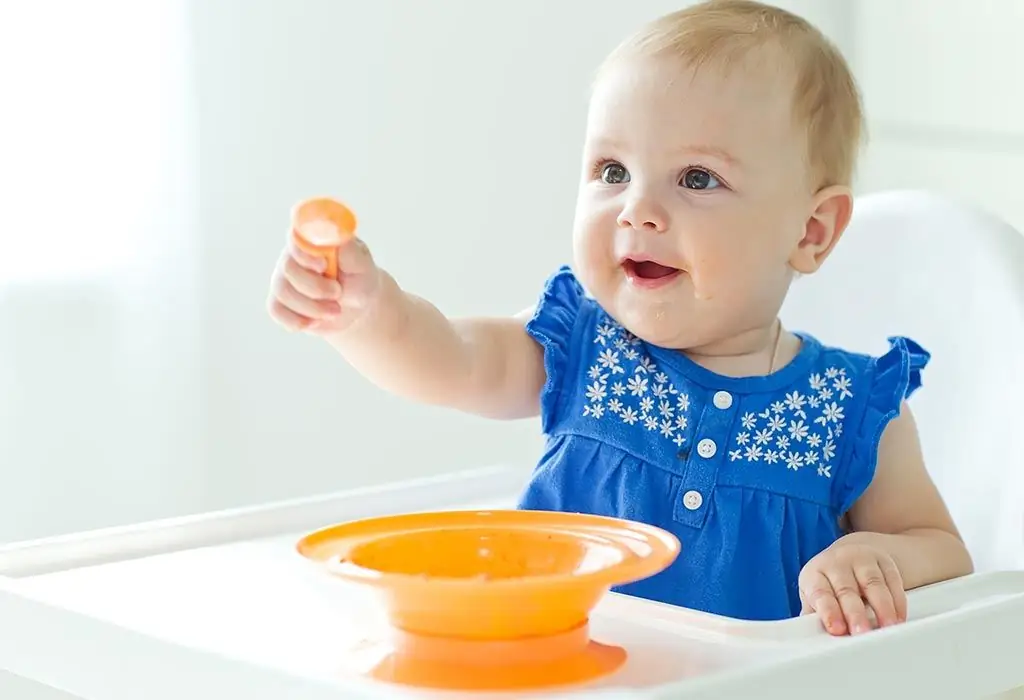2026 Author: Priscilla Miln | [email protected]. Last modified: 2025-01-22 17:55:24
The introduction of foods from the adult table, or otherwise complementary foods, for all children is another important stage in development. As a rule, by this age, mothers have already begun to actively add mixtures or something else to breast milk. Everything happens individually, despite the existing recommendations of pediatricians and WHO. Ideally, the start of complementary foods occurs at 5-6 months, for artificial ones a month earlier.
What should be the menu of an eight-month-old baby? When is a particular product introduced if the child is bottle-fed? It is worth understanding this issue before proceeding with the action. Experienced parents consult with each other and seek help on the Internet. Pediatricians also recommend adhering to the WHO established complementary feeding scheme and monitoring how the baby reacts to the new product.
How do you know if your baby is ready to feed?

Doctors and experienced parents believe that the introduction of products from the adult table should not be in a hurry. According to generally accepted rules, the optimal time forthe start of complementary foods is when the baby:
- Shows interest in his parents' food.
- Sits on his own.
- Does not push spoon out with tongue.
- The amount of breast milk is not enough to saturate his body.
If the menu of an eight-month-old baby has so far consisted only of breast milk or formula, then the first portions of the new product should not be more than half or a teaspoon. It is worth paying attention to how the baby reacts to the taste. Since baby food does not contain s alt and sugar, it may seem completely tasteless to an adult. Therefore, you should not expect that the child will happily gobble up mashed potatoes from a jar with great appetite. Of course, you can cook it yourself, especially since the first portions will be quite small.
Common mistakes when entering a product

Wishing to diversify the menu of an eight-month-old baby (this applies to those who have just started complementary foods), parents very often make one mistake: they try to force-feed the baby. Persuasion and even resentment that the child does not react in any way to a new product can only do harm. Moreover, both sides will suffer.
Also, don't deprive your baby of your favorite breast milk or formula. An adult should understand that the first products from an adult table in the form of mashed potatoes or porridge should not immediately become their replacement. The main task of the parent at the addiction stage is to let the baby understand that food from an adult table can also be delicious. It is important to draw up a rough menu for the week in advance.eight month old baby.
Since the child's body is prone to an allergic reaction, and it, in turn, tends to accumulate, pediatricians recommend not to abuse the introduction of allergenic foods into complementary foods. Even if the child does not have a reaction to such food at first, it is likely that it will manifest itself over time.
To make the nutrition of an eight-month-old baby correct and balanced, you should understand when and what foods should be included in the menu. The time of day also has a certain meaning, it will be better if it is in the morning or before lunch. The baby should be given special cutlery that is comfortable to hold in a child's hand.
Green light for he althy cereals

If mom has already introduced one-component fruit and vegetable puree to the menu of an eight-month-old baby, then the next step is cereals. Pediatricians recommend starting with those cereals that do not cause allergies and do not contain milk. During the initial introduction to complementary foods, attention should be paid to corn (when boiled, it becomes similar in consistency to semolina), rice groats. Some manufacturers indicate that buckwheat and oatmeal can also be included in this list. However, experienced mothers advise to be careful with them and boil the cereal as best as possible. Since the baby still does not know how to properly chew food and is only learning to swallow food from a spoon correctly, there is a risk that he may choke on grains of cereals.
Multi-cereal porridges are suitable for those kids who have already managed to get to know each other by this age.porridge and eat them well. At the same time, the menu of an eight-month-old baby on artificial feeding does not differ from the baby. The exception is babies who eat a milk-based formula. According to the practice of introducing complementary foods, multi-cereal cereals with milk can be introduced into the menu from just eight months. Complementary foods are started in the same way as with the introduction of any other product - with half a teaspoon. And even if the baby ate it with interest, you should not exceed this portion at the first stage. Otherwise, you may get an upset stomach, colic, or an allergic reaction.
Cooking porridge
Cooking porridge at home is not difficult at all. To do this, you must first grind the cereal into powder and only then proceed to cooking. At the stage of introducing a new product and until the baby has chewing teeth, it is worth refraining from food with lumps or cereals that need to be chewed.
If a parent uses ready-made porridge bought in a store, then it is enough to fill it with water, cover with a lid and let stand for a while. After the cereal swells, it should be mixed and can be served on the baby's table. Self-cooking porridge takes a little more time. It is more difficult to independently calculate the ratio of cereals and milk / water.
To make buckwheat porridge you will need:
- Grout - 1 tsp
- Pure water - 50 ml.
- Milk - 125 ml.
Add water to milk, bring to a boil, add grits, stirring constantly. Cook porridge on a slowfire or on low power until the mass thickens.
Cooking rice groats requires a different proportion: 2 tbsp. l. - cereals, water - 250 ml, milk - 125 ml. If you cook whole grain cereals, then at the end of cooking it will need to be rubbed through a sieve.
Meat products
Introduction to meat products (important suppliers of iron and protein) must be started very carefully. The most optimal option for starting complementary foods is rabbit, veal, later it is recommended to introduce beef, turkey, chicken. In the menu of an eight-month-old bottle-fed baby or baby, meat should only be in the form of mashed potatoes. There should be no s alt in the finished dish. When buying a product in a store, it is advisable to give preference to those goods that are packaged in cans, like canned food. Also pay attention to the date of manufacture. If an adult is preparing mashed meat at home, you will need to make sure that it is cooked without lumps or pieces of meat.
Each baby reacts to complementary foods differently, and may need to sort through different brands of food before choosing one. Over time, his taste habits will change, so do not think that once he refuses beef, the baby will never touch it again.
Having gradually de alt with meat purees, you can switch to light meat broths and liquid soups based on vegetable broth. At the same time, do not exceed the recommended dosage for this: one serving up to a year should not beover 150 g.
Fish

Amino acids, vitamin D, trace elements and useful Omega-3s can enter the body not only with breast milk or special mixtures, but also with the introduction of fish into the diet of an eight-month-old baby. It’s worth starting with low-fat varieties that will not harm the baby’s digestive system. It can be cod, hake, pike perch. A greater choice on the baby food market allows you to get a ready-made product at a bargain price. However, some people prefer to make puree at home. In this case, you should be very careful and eliminate the risk of getting fish bones.
When the baby gets used to meat and fish puree, you can mix them with vegetables: potatoes, broccoli, cauliflower, carrots. In this case, the number of two components can be divided in equal proportions. It is advisable to keep a glass of water or compote on the table during feeding. Often, after eating fish, thirst arises, the baby should not be denied additional fluid intake.
Milk

By eight months, the baby is already familiar with a number of products that are on the adult table, including milk. The easiest thing is to develop a menu for an eight-month-old bottle-fed baby. As a rule, at this age, most mixtures are made with milk. The exceptions are children prone to allergies, and those who have milk protein intolerance. They can be offered to replace cow's milk with goat's, whicheasier to digest for children. The downside is the price, and the smell can upset your appetite.
The product should be chosen with medium fat content, 2.5-3.2%. Now there is a special baby milk on sale, which is packaged in a tetrapack and even has a vitamin premix in the composition. This is undoubtedly a plus, but it is also important to pay attention to the expiration date. If the finished product can be stored for more than a week, then it contains preservatives, which is highly undesirable for a child's body.
Dairy products
Well-known pediatricians recommend starting to introduce sour-milk mixtures into the menu of an eight-month-old baby on artificial feeding. They will prepare the child's body to receive dairy products in their pure form. It is better if it is kefir, it least of all leads to gas formation. Also, in its properties, it is close to breast milk. Further, it is recommended to add yogurt to the diet of an eight-month-old baby and only then cottage cheese. The latter is more viscous and dense in consistency, and the baby, if he has just begun to join the adult table, may have difficulty swallowing food.
Kefir starts with a teaspoon, the increase in portions should occur gradually. By the end of the eighth month, the volume of a serving of a fermented milk product can be brought up to 100 ml. If the baby is breastfed, then it is advisable to take kefir in the evening, before feeding with breast milk or formula before bedtime.
Even if a child drinks kefir with great pleasure, it is not recommended to exceed the volumeportions of more than 100 ml, and up to a year no more than 200 ml. The advantage of kefir is that it contains a large number of bifidobacteria. They help improve the functioning of the intestinal microflora, strengthen the immune system and reduce the risk of developing various infectious diseases.
Cottage cheese

Parents who adhere to the complementary feeding scheme recommended by the pediatrician begin to introduce the baby to cottage cheese two months after the main products have already been introduced. In the menu of an eight-month-old breastfed baby, it is also introduced from a small portion (0.5 tsp). By the end of the month after the start of complementary foods, it should be brought up to 30 g and by the year up to 50 g. You should not rush, as well as abuse it. If the baby does not like eating lean cottage cheese, then the mother can dilute it with baby yogurt or fruit puree. Naturally, here it is worth making a reservation that if you are prone to allergies, you will have to refuse additives.
A pediatrician may recommend adjusting an eight-month-old baby's menu for the day in case he is not gaining weight well. However, do not abuse this and exceed the amount of cottage cheese, if there are no other prerequisites.
You can cook the product at home. Experienced parents often use natural milk and special starter cultures. If it is difficult to find it on sale, then curdled milk, sour cream or kefir will do as an alternative.
To get the most tender cottage cheese at home, you will need:
- 1L cow's milk;
- 50-75 ml sour cream, kefiror curdled milk.
Milk must be brought to a boil, cooled to 40 degrees. Here you will need a special food thermometer. Sourdough is added to the slightly cooled liquid. The fermentation process takes some time. You can understand that the mass is ready by consistency, it looks like kefir. Then the container with sour milk is again placed on the stove. On low heat, it will stand until the whey begins to separate. The pan should be removed from the stove. Milk and whey are poured into a colander prepared in advance, covered with gauze. In order for the excess moisture to come off and the curd to dry out, it is hung in gauze, tied tightly. In this form, it should hang for 5-6 hours.
Compotes and cookies

You can include compotes in the menu of an eight-month-old breastfed baby after fruit purees have been introduced and there has been no allergic reaction to them. Undoubtedly, this drink is rich in vitamins and perfectly quenches thirst. Making compote at home is quite simple. Both dried and fresh fruits and berries are used. Another advantage of making your own drink is the ability to control the quality of the ingredients and the amount of sugar.
If you look at the approximate menu of an eight-month-old child who is bottle-fed, then pediatricians recommend introducing compotes from three to five months. In this case, the concentrate should turn out to be weak and absolutely sugar-free. Fruits (apricots, apples, pears) should be sweet on their own. Baby, atwhich has problems with digestion, as well as frequent constipation, the parent can prepare a decoction of prunes. It is enough to take 5-6 pieces. and pour boiling water, let stand until the infusion reaches room temperature. Often, a few tablespoons are enough to eliminate unpleasant symptoms.
Diversify the nutrition of an eight-month-old breastfed baby with a special baby cookie. Modern manufacturers offer a natural composition that is rich in vitamins and does not have unnecessary additives. Many kids enjoy eating cookies, even if the first teeth have just begun to break through. It easily soaks in the mouth, the main thing is to make sure that the child does not bite off too large a piece. Since this product is a dessert, it should not be given very often.
Sample menu
Here is an example of a possible daily diet for a baby:
- First feeding. Mom's breast milk - about 200 milliliters of milk per feeding.
- Second breakfast. Milk porridge: buckwheat, oatmeal, rice. Offer fruit puree for dessert.
- Lunch. Vegetable soup, a meat dish or meat puree with vegetables, fish, bread with boiled chicken yolk are also perfect for lunch. After eating, you can offer your baby a drink - fruit juice, compote or some tea.
- Dinner. Offer the baby kefir or juice, as well as some bread or cookies. Finally, offer your baby milk.
- Second dinner. Like an early breakfast, the very last meal at eight months for crumbs on the chestbreastfeeding consists of milk.
Recommended:
First complementary foods for breastfeeding and artificial feeding. Porridge for the first feeding

Time passes, and there comes a moment when the milk is not enough for the baby. The newborn is not too mobile - he constantly lies and most of the time is immersed in sleep. He spends few calories, so milk is perfectly enough to give the most intensive weight gain for the infant period. This continues for up to six months. By 6 months, the activity of the baby noticeably increases
Constipation in the baby. Komarovsky E.O. about constipation in infants during breastfeeding, artificial feeding and with the introduction of complementary foods

Such a problem as constipation occurs frequently in infants. Not all parents know how to behave in this case. The famous children's doctor E. O Komarovsky recommends young mothers not to worry, but to carefully monitor the condition of the child
Child menu 8 months on artificial and breastfeeding

The menu of a child at 8 months is quite diverse. At this age, he is offered a lot of products from the "adult" table, rich in vitamins and other useful substances. Every mother is concerned about the question of how to make the baby's nutrition balanced. After all, a growing organism must receive all the necessary trace elements. Let's get acquainted with the generally accepted norms and recommendations of pediatricians
Feeding geese: breeding features, feeding norms and diet, advice from experienced farmers

What should be the feeding of geese for their full development and growth? This question is asked by every novice farmer. Birds are unpretentious to feed, but certain rules should be followed in order to make a balanced diet. Only in this case, you can avoid problems with the he alth of domestic birds. In addition, not all grass is suitable for geese - some plants are poisonous for these birds
Yellow feces in a newborn. What should be the stool in newborns during breastfeeding and artificial feeding

In children during the first months of life after birth, the digestive system does not work properly. Their microflora and intestinal motility are just beginning to form. If any problems arise, the stool changes its consistency, color and smell, on the basis of which it is possible to identify them in time. For example, yellow feces in a newborn are considered very common

